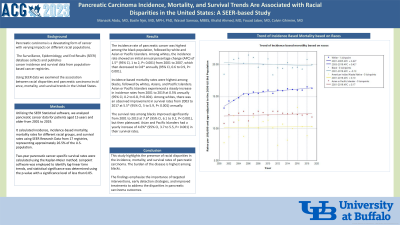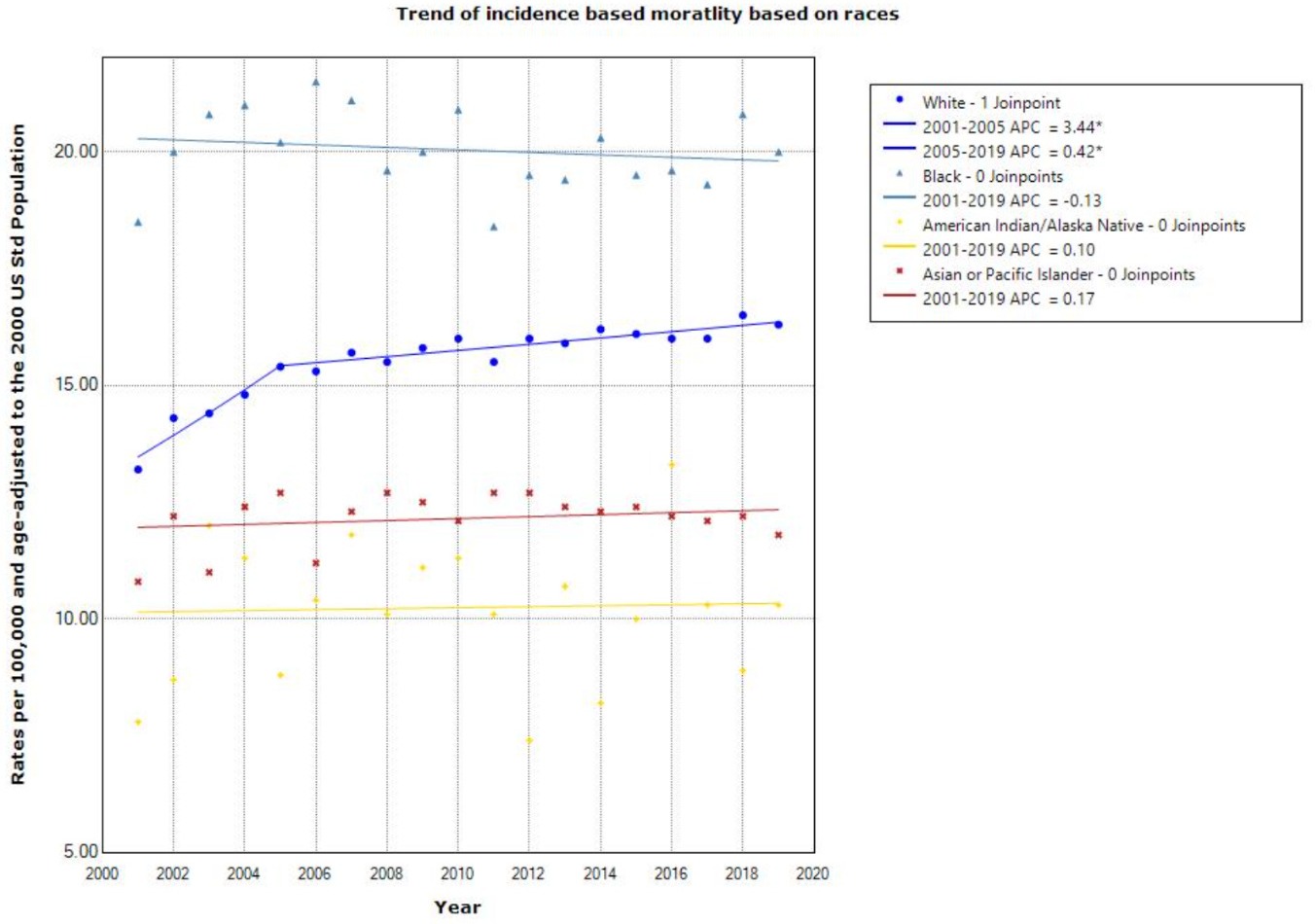Tuesday Poster Session
Category: Biliary/Pancreas
P2866 - Pancreatic Carcinoma Incidence, Mortality, and Survival Trends Are Associated with Racial Disparities in the United States: A SEER-based Study
Tuesday, October 24, 2023
10:30 AM - 4:00 PM PT
Location: Exhibit Hall

Has Audio

Manasik Abdu, MD
University at Buffalo-Catholic Health System
Buffalo, NY
Presenting Author(s)
Manasik Abdu, MD1, Basile Njei, MD, MPH, PhD2, Wassel Sannaa, MBBS3, Khalid Ahmed, MD4, Fouad Jaber, MD5, Calvin Ghimire, MD6
1University at Buffalo-Catholic Health System, Buffalo, NY; 2Yale School of Medicine, New Haven, CT; 3Mayo Clinic, Rochester, MN; 4The Wright Center for GME, Scranton, PA; 5University of Missouri-Kansas City, Kansas City, MO; 6Michigan State University/McLaren Flint Hospital, Flint, MI
Introduction: Pancreatic carcinoma is a devastating form of cancer with varying impacts on different racial populations. The Surveillance, Epidemiology, and End Results (SEER) database collects and publishes cancer incidence and survival data from population-based cancer registries. Using SEER data we examined the association between racial disparities and pancreatic carcinoma incidence, mortality, and survival trends in the United States.
Methods: Utilizing the SEER Statistical software we analyzed pancreatic cancer data for patients aged 15 years and older from 2001 to 2019. It calculated incidence, incidence-based mortality, mortality rates for different racial groups, and survival rates using SEER Research Data from 17 registries, representing approximately 26.5% of the U.S. population. Two-year pancreatic cancer-specific survival rates were calculated using the Kaplan-Meier method. Joinpoint software was employed to identify log-linear time trends, and statistical significance was determined using the p-value with a significance level of less than 0.05.
Results: The incidence rate of pancreatic cancer was highest among the black population, followed by white and Asian or Pacific Islanders. Among whites, the incidence rate showed an initial annual percentage change (APC) of 1.5* (95% CI, 1 to 2, P< 0.001) from 2001 to 2007, which then decreased to 0.8* annually (95% CI, 0.6 to 0.9, P< 0.001). Incidence-based mortality rates were highest among blacks, followed by whites, Asians, and Pacific Islanders. Asian or Pacific Islanders experienced a steady increase in incidence rates from 2001 to 2019 at 0.5% annually (95% CI, 0.2 to 0.8, P=0.001). Among whites, there was an observed improvement in survival rates from 2003 to 2017 at 5.5* (95% CI, 5 to 5.9, P< 0.001) annually. The survival rate among blacks improved significantly from 2001 to 2013 at 7.6* (95% CI, 6.1 to 9.2, P< 0.001), but then plateaued. Asian and Pacific Islanders had a yearly increase of 4.6%* (95% CI, 3.7 to 5.5, P< 0.001) in their survival rates.
Discussion: This study highlights the presence of racial disparities in the incidence, mortality, and survival rates of pancreatic carcinoma. The burden of the disease is highest among blacks. The findings emphasize the importance of targeted interventions, early detection strategies, and improved treatments to address the disparities in pancreatic carcinoma outcomes.

Disclosures:
Manasik Abdu, MD1, Basile Njei, MD, MPH, PhD2, Wassel Sannaa, MBBS3, Khalid Ahmed, MD4, Fouad Jaber, MD5, Calvin Ghimire, MD6. P2866 - Pancreatic Carcinoma Incidence, Mortality, and Survival Trends Are Associated with Racial Disparities in the United States: A SEER-based Study, ACG 2023 Annual Scientific Meeting Abstracts. Vancouver, BC, Canada: American College of Gastroenterology.
1University at Buffalo-Catholic Health System, Buffalo, NY; 2Yale School of Medicine, New Haven, CT; 3Mayo Clinic, Rochester, MN; 4The Wright Center for GME, Scranton, PA; 5University of Missouri-Kansas City, Kansas City, MO; 6Michigan State University/McLaren Flint Hospital, Flint, MI
Introduction: Pancreatic carcinoma is a devastating form of cancer with varying impacts on different racial populations. The Surveillance, Epidemiology, and End Results (SEER) database collects and publishes cancer incidence and survival data from population-based cancer registries. Using SEER data we examined the association between racial disparities and pancreatic carcinoma incidence, mortality, and survival trends in the United States.
Methods: Utilizing the SEER Statistical software we analyzed pancreatic cancer data for patients aged 15 years and older from 2001 to 2019. It calculated incidence, incidence-based mortality, mortality rates for different racial groups, and survival rates using SEER Research Data from 17 registries, representing approximately 26.5% of the U.S. population. Two-year pancreatic cancer-specific survival rates were calculated using the Kaplan-Meier method. Joinpoint software was employed to identify log-linear time trends, and statistical significance was determined using the p-value with a significance level of less than 0.05.
Results: The incidence rate of pancreatic cancer was highest among the black population, followed by white and Asian or Pacific Islanders. Among whites, the incidence rate showed an initial annual percentage change (APC) of 1.5* (95% CI, 1 to 2, P< 0.001) from 2001 to 2007, which then decreased to 0.8* annually (95% CI, 0.6 to 0.9, P< 0.001). Incidence-based mortality rates were highest among blacks, followed by whites, Asians, and Pacific Islanders. Asian or Pacific Islanders experienced a steady increase in incidence rates from 2001 to 2019 at 0.5% annually (95% CI, 0.2 to 0.8, P=0.001). Among whites, there was an observed improvement in survival rates from 2003 to 2017 at 5.5* (95% CI, 5 to 5.9, P< 0.001) annually. The survival rate among blacks improved significantly from 2001 to 2013 at 7.6* (95% CI, 6.1 to 9.2, P< 0.001), but then plateaued. Asian and Pacific Islanders had a yearly increase of 4.6%* (95% CI, 3.7 to 5.5, P< 0.001) in their survival rates.
Discussion: This study highlights the presence of racial disparities in the incidence, mortality, and survival rates of pancreatic carcinoma. The burden of the disease is highest among blacks. The findings emphasize the importance of targeted interventions, early detection strategies, and improved treatments to address the disparities in pancreatic carcinoma outcomes.

Figure: Incidence-based Mortality Based on Races
Disclosures:
Manasik Abdu indicated no relevant financial relationships.
Basile Njei indicated no relevant financial relationships.
Wassel Sannaa indicated no relevant financial relationships.
Khalid Ahmed indicated no relevant financial relationships.
Fouad Jaber indicated no relevant financial relationships.
Calvin Ghimire indicated no relevant financial relationships.
Manasik Abdu, MD1, Basile Njei, MD, MPH, PhD2, Wassel Sannaa, MBBS3, Khalid Ahmed, MD4, Fouad Jaber, MD5, Calvin Ghimire, MD6. P2866 - Pancreatic Carcinoma Incidence, Mortality, and Survival Trends Are Associated with Racial Disparities in the United States: A SEER-based Study, ACG 2023 Annual Scientific Meeting Abstracts. Vancouver, BC, Canada: American College of Gastroenterology.
